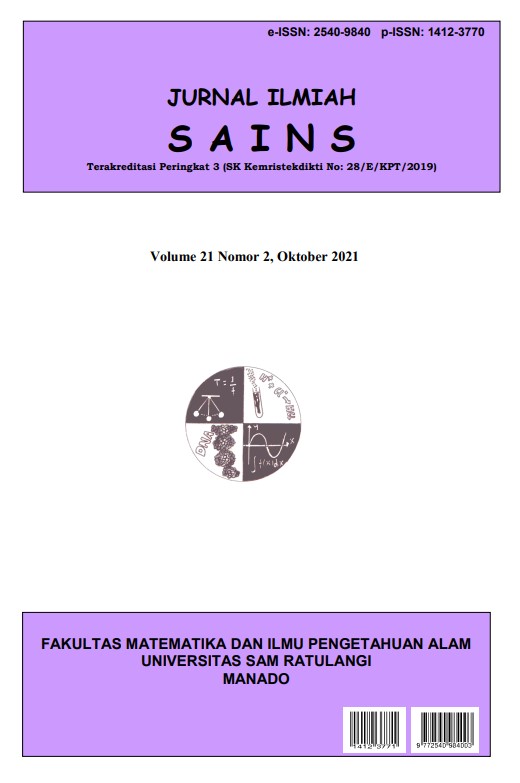Antibacterial Activity Testing on APMS (p-Methoxy Cinnamic Acid) Against Escherichia coli Bacteria
DOI:
https://doi.org/10.35799/jis.v21i2.35684Abstract
This study aims to determine whether the compound APMS (p-methoxy cinnamic acid) has the antibacterial activity of Escherichia coli and to determine the effective concentration of the compound APMS (p-methoxy cinnamic acid) in inhibiting the growth of Escherichia coli bacteria. This research begins with the synthesis of APMS obtained through the knoevenagel condensation reaction with the sonochemical method. The synthesized compounds were tested organoleptically and their melting points were measured. The structure of the results was elucidated using FT-IR and GC-MS, then tested the antibacterial activity of APMS compounds against Escherichia coli. Data analysis with SPSS, 99% confidence level (p<0.01) and continued with ANOVA test. The compound synthesized by APMS is in the form of fine crystals with a glossy white color, has a characteristic odor, and produces a % yield of 92.71%. The level of p-methoxy cinnamic acid (APMS) produced from this study was 95% using the GC-MS Instrument. APMS compounds have antibacterial activity against Escherichia coli. The average inhibition zone formed at a concentration of 5%; 10%; and 15% respectively are 0.695 cm; 0.727 cm; and 0.855 cm The optimal concentration of this study was at a concentration of 15% which gave the greatest inhibition
Keywords: Antibacterial; Escherichia coli; p-Methoxy cinnamic acid
Uji Aktivitas Antibakteri Senyawa APMS (Asam p_Metoksi Sinamat) Terhadap Bakteri Escherichia coliÂ
ABSTRAK
Penelitian ini bertujuan untuk mengetahui apakah senyawa APMS (Asam p-metoksisinamat) memiliki aktivitas antibakteri Escherichia coli dan mengetahui konsentrasi efektif dari senyawa APMS (Asam p-metoksisinamat) dalam menghambat pertumbuhan bakteri Escherichia coli. Penelitian ini diawali dengan sintesis APMS ini didapatkan melalui reaksi kondensasi knoevenagel dengan metode sonokimia. Senyawa hasil sintesis diuji organoleptis dan diukur titik leburnya. Struktur hasil dielusidasi menggunakan FT-IR dan GC-MS, kemudian uji aktivitas antibakteri senyawa APMS terhadap Escherichia coli. Analisis data dengan SPSS, tingkat kepercayaan 99% (p<0,01) dan dilanjutkan uji ANOVA. Senyawa hasil sintesis APMS berupa kristal halus berwarna putih mengkilap, memiliki bau khas, dan menghasilkan % yield sebesar 92,71%. Kadar Asam Para Metoksisinamat (APMS) yang dihasilkan dari penelitian ini sebesar 95% menggunakan Instrumen GC-MS. Senyawa APMS memiliki aktivitas antibakteri terhadap Escherichia coli. Rataan zona hambat yang terbentuk pada konsentrasi 5%; 10%; dan 15% secara berturut adalah 0,695 cm; 0,727 cm; dan 0,855 cm Konsentrasi yang optimal dari penelitian ini adalah pada konsentrasi 15% yang memberikan daya hambat yang paling besar.
Kata kunci: Â Antibakteri; Asam p-metoksi sinamat; Escherichia coli
References
Babu, P.N.K., Devi, B.R. & Dubey, P.K. 2013. Ultrasound assisted convenient, rapid and environmentally benign synthesis of N-alkylbenzimidazoles. Der Chemica Sinica, 4(1):105–110.
Chiriac, C.I., Tanasa, F. & Nechifor, M. 2009. A novel direct boron-mediated synthesis of cinnamic acids from aromatic aldehydes and aliphatic carboxylic acids. Revue Roumaine de Chimie, 54(11–12):987–991.
Ekowati, J., Astika, W.D.N. & Budiati, T. 2010. Pengaruh Katalis pada Sintesis Asam O-Metoksisinamat dengan Material Awal O-Metoksi Bezaldehide dan Uji Aktivitas Analgesiknya. Majalah Farmasi Irlangga, 8(2).
Ernawati, T., Budiana, A. & Ernawati, T. 2016. Bioaktivitas Turunan Metil Sinamat Terhadap Pertumbuhan Bakteri Escherichia coli, Staphylococcus aureus, Bacillus subtilis, Pseudomonas aureugenosa dan Jamur Candida albicans. Jurnal Kimia VALENSI, 1(1):60–64. https://doi.org/10.15408/jkv.v0i0.3154.
Ghomi, J.S. & Akbarzadeh, Z. 2018. Ultrasonic accelerated Knoevenagel condensation by magnetically recoverable MgFe2O4 nanocatalyst: A rapid and green synthesis of coumarins under solvent-free conditions. Ultrasonics Sonochemistry, 40:78–83. https://doi.org/10.1016/j.ultsonch.2017.06.022.
Guzman, J.D. 2014a. Natural cinnamic acids, synthetic derivatives and hybrids with antimicrobial activity. Molecules. https://doi.org/10.3390/molecules191219292.
Guzman, J.D. 2014b. Natural cinnamic acids, synthetic derivatives and hybrids with antimicrobial activity. Molecules, 19: 19292–19349. https://doi.org/10.3390/ molecules191219292.
Hidajati, N. & Suyatno. 2008. Sintesis Senyawa Tabir Matahari n-Oktil Para-Metoksi Sinamat Menggunakan Material Awal Etil Para-Metoksi Sinamat Hasil Isolasi dari Rimpang Kencur (Kaemferia galanga L .) Synthesis of a Sunscreen Compound n-Octyl Para-Menthoxy Cinnamat using Ethyl Para-M. Jurnal Ilmu Dasar, 9(1):22–27.
Hoai, N.T., Ngoc, T.T.Y., Nam, N.D., Thuy, T.T., Trang, C.T.T., Hai, N.D. & Nguyen, T.K. 2018. Effect of β-alanine on the preparation of 4-ethoxy-cinnamic acid. Open Materials Science Journal, 12(1):58–67. https://doi.org/ 10.2174/1874088X01812010058.
Indriyanti, E. & Prahasiwi, M.S. 2020. Synthesis of cinnamic acid based on perkin reaction using sonochemical method and its potential photoprotective agent. 5(1):54–61.
Korošec, B., Sova, M., Turk, S., Kraševec, N., Novak, M., Lah, L. & Komel, R. 2014. Antifungal activity of cinnamic acid derivatives involves inhibition of benzoate 4-hydroxylase (CYP53). Journal of Applied Microbiology, 116(4):955–966. https://doi.org/10. 1111/jam.12417.
Lipase, I., Candida, B., Rychlicka, M. & Gliszczy, A. 2020. With p-Methoxycinnamic Acid Catalyzed by.
Narasimhan, B., Belsare, D., Pharande, D., Mourya, V. & Dhake, A. 2004. Esters, amides and substituted derivatives of cinnamic acid: Synthesis, antimicrobial activity and QSAR investigations. European Journal of Medicinal Chemistry, 39(10):827–834. https://doi. org/10.1016/j.ejmech.2004.06.013.
Patel, B.R., Desai, D.H. & Raval, J.P. 2014. Green Efficient Synthesis of Aryl Thioamides Using Ultrasound: A Comparative Study. Journal of Pharmacy And Applied Sciences, 1(1):29–33.
Septian, A.N., Kusoro, S. & Sudarmin. 2012. Abstrak Abstract. Uji Antimikroba Etil P-Metoksi Sinamat Dari Rimpang Krncur Terhadap Bacillus Subtilis, 1(2252):98–103. https://doi.org/10. 14710/teknik.v37n2.9011.
Sharma, P. 2011. Cinnamic acid derivatives: A new chapter of various pharmacological activities. Journal of Chemical and Pharmaceutical Research, 3(2):403–423.
Silalahi, M. 2019. Kencur (Kaempferia galanga) dan bioaktivitasnya. Jurnal Pendidikan Informatika Dan Sains, 8(1):127. https://doi.org/10.31571/ saintek.v8i1.1178.
Sova, M. 2012. Antioxidant and Antimicrobial Activities of Cinnamic Acid Derivatives. Mini-Reviews in Medicinal Chemistry. https://doi.org /10.2174/138955712801264792
Syarifatul, M. 2014. Modifikasi Struktur Senyawa Etil p-metoksisinamat yang Diisolasi dari Kencur (Kaempferia galanga Linn.) Melalui Transformasi Gugus Fungsi Serta Uji Aktivitas Sebagai Antiinflamasi [Skripsi]. UIN Syarif Hidayatullah, Jakarta.







